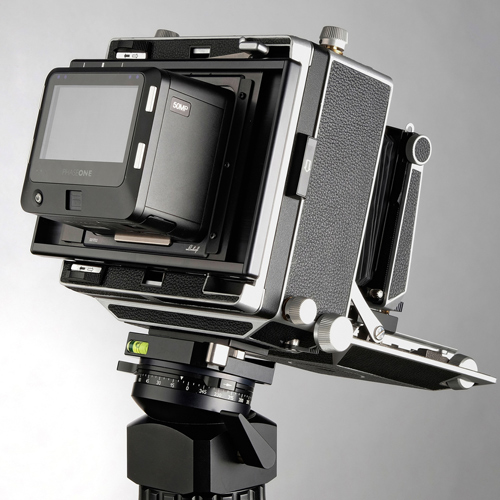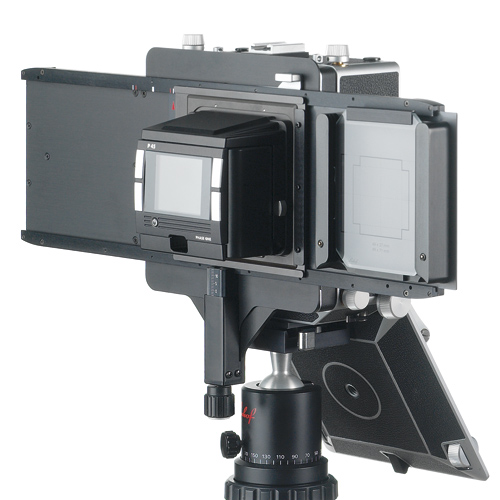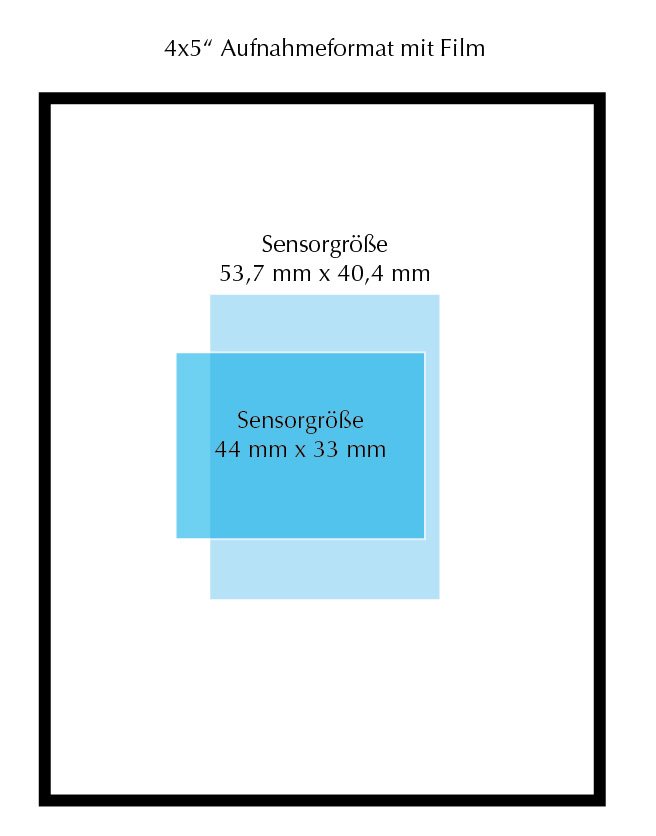The most important characteristic of view cameras used is the large shooting format. Decisive for the use of the view camera is the mechanical adjustability, i.e. perspective corrections, rectification of converging lines or the Scheimpflug rule.
he Digi Adapter 001693 for International Back 4×5 is equipped with a Hasselblad V connector. It creates the connection from conventional 4×5 cameras to digital backs adapted to Hasselblad V. With an appropriate ground glass mask, the image plane can be marked on the ground glass. The image plane must of course be matched.
A special changeable slide is available for the Master Technika cameras (001618). This allows the Master Technika to be used for subject photography with digital backs with ground glass control. This is recommended as an accessory for the RD1 repro camera.
The prerequisite for this is the easily removable rotating back. The MT interchangeable slide allows quick changeover from setting on the groundglass to shooting. It accepts the camera adapter plates for connecting the various digital backs (Hasselblad H, Hasselblad V, Mamiya 645 AF/AFD). The built-in shift allows the entire interchangeable carriage to be shifted 15 mm up and 15 mm down. Multiple exposures (stitching) increase the shooting area of the digital backs.
Camera adapter plates, focusing screens and viewing systems are the same as for the universal interchangeable carriage.
However, those who use digital backs with large view cameras must accept limitations. Please refer to the following sections.
Let’s look at the size of the digital backs: With a chip size of 53.7 mm x 40.4 mm (PhaseOne, Leaf), 43.8 × 32.9 mm (Hasselblad), to name just a few examples, the digital imaging area of the sensors is far below the classic large format 4×5. The same applies to the lenses, or more precisely the lens focal lengths and image circles.
Large format cameras, which were designed for shooting on conventional film and considerably larger shooting formats, now have to be adapted to the requirements of the small sensor formats. The diagram illustrates the size ratio of a 4×5″ flat film to currently common sensor sizes of digital backs. The 4×5 or 9×12 view cameras (or even larger) are exactly adapted to this large recording area in their mechanics, their adjustment paths and the corresponding large format lenses. However, if “only” a small area is to be captured in the highest resolution, digital lenses should be used – in order to meet all quality requirements – which in turn do not have such a large image circle to take advantage of the mechanics of the large view cameras. And this is exactly where compromises have to be made!
The huge adjustment ranges of the view cameras quickly bring the actual recording format of the digital backs to the edge of the image circle, and the light rays fall obliquely onto the recording surface. This causes color shifts and quality losses. The color shifts can be compensated with a calibration (exposure through opal disk and subsequent calibration in the acquisition software of the digital backs).
Not all 4×5 view cameras have optimal fine drives for setting the minimum necessary adjustment paths – whether for focusing or for camera adjustments – as precisely as necessary. This is especially necessary when shooting with live view, where control is via the monitor.
For 6×9 cameras such as the Linhof Technikardan S 6×9 and the Master Technika 6×9, the universal digi-adapter 6×9 for camera adapter plates, code 001691, is available. This then allows the digital backs to be attached directly with corresponding adapter plates 001700, 001701, 001702.
Digital backs require specially corrected digital lenses in order to exploit the full quality of their resolution. These lenses, in turn, have image circles that are matched to the chip sizes, i.e. the image areas of the digital backs. Of course, this means that the adjustment paths of large 4×5 view cameras can only be used to a small extent.
The focal lengths also work according to the shooting format (rule of thumb: normal lens corresponds approximately to the format diagonal). Wide-angle shots are also only possible to a limited extent due to the design of large view cameras. The necessary (short) flange focal length is often not achieved.
With the M 679cs and the Techno, Linhof offers two camera models that meet all the requirements of high-end digital photography. Thus, direct and indirect parallel shifts for perspective control as well as focus shifts according to Scheimpflug are also possible in digital photography.
The view camera designs of the Linhof M 679cs and the Linhof Techno accommodate the shooting area of the digital backs. The necessary adjustment paths are based on the recording format. Digital lenses for these view cameras offer the necessary high resolutions and the correspondingly large image circles to use camera adjustments sensibly and in high-end quality.



